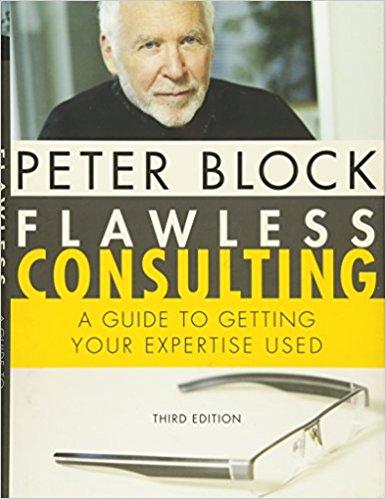Flawless Consulting Summary

<1 min read ⌚
 A Guide to Getting Your Expertise Used
A Guide to Getting Your Expertise Used
If you are a consultant who wants to become more successful in the consultancy job, than today is your lucky day!
We have a treat for you, in the form of a summary of “Flawless Consulting,” the step by step guide to building healthy consultant relationships.
Who Should Read “Flawless Consulting”? And Why?
“Flawless Consulting” is centered around a clear message: build relationships, stop dressing up and trust your instincts.
Consulting can be learned and “Flawless Consulting” is where you should start.
We recommend Block’s book to teachers, coaches, consultants, and managers, as well as all other groups we did not mention, but work individually with clients.
About Peter Block
 Peter Block is a writer, speaker, and consultant in civic engagement, organizational development, and community building.
Peter Block is a writer, speaker, and consultant in civic engagement, organizational development, and community building.
“Flawless Consulting Summary”
Consulting is not an inborn talent – it is a skill that can be learned.
Now, your goal is to learn how to use this skill successfully.
There are two types of consultants: “internal consultants” who have a supporting role inside a company, or an “external consultant” who has no implementation power and any direct influence on the company.
There will be times when you will feel a conflict between the changes you want to implement and your client’s wishes. When your hands are tied, tense situations can happen.
So, how can you keep these tense situations as rare as possible?
Well, the only way to do it is to work on yourself and your interpersonal, consulting and technical skills.
Developing these skills will help you in each struggle you find yourself in.
To be a consultant, you do not need just to know how to solve exact problems. You need to know how to get to the softer side of client relations as well.
If you are able to offer the right solution to a problem, you are just beginning your consulting journey. You will also have to define and diagnose different potential conflicts that could arise between you and your client.
However, how can you practice “flawless consulting”?
“Flawless consulting” means being truthful, and giving as direct and straightforward responses as you can to all of your client’s questions.
There are three roles you can assume as a consultant, which we cover in the key lessons below. The important thing you should know about all of these roles is that they aim to help you build a long-term bond with your client.
Whenever you decide to work with a client, you are entering a consulting contract. Such an arrangement means that you both are agreeing with each other’s expectations.
In other words, you are both entering the consulting relationship voluntarily, and agree on an expected value you will receive.
These two points may be harder to apply when you serve as an internal consultant.
If you experience some difficulties when trying to come up with an agreement, do not worry – it is entirely normal.
In such cases try to decode the ways people communicate in the organization you are working for, to decide what your client means when he or she says some things.
If you think that your client is keeping something away from you, you can go about it in different ways:
- Without saying anything
- By addressing the point directly
- By adjourning
- By creating space and time for reflection
Communicating with a particular client means that you are creating an image of your client’s organization. When asked for consultancy, be as transparent as possible. Explain what is the source of your client’s issues and why do those problems continue occurring.
Do not just explore technicalities, study the way people interact with the organization as well.
Note that what you say and what your client thinks the problem actually represents two very different things. In fact, they should be different, since your client has failed to resolve the issue, which means that their understanding of the situation is not complete.
Add value by discovering new things about the roots of the problems, and coming up with proper solutions.
Remember that you can come to a solution only if you diagnose the real problem first.
Another thing you should remember is always to be the third detached party in the situation.
Observe the organization objectively, since only then you can come to the desired outcome.
One approach to take is the “whole-system approach” which involves both managers and teams.
Furthermore, there is the holistic approach which will give you the responsibility to make your client’s staffers question their beliefs and create learning experiences for them.
Of course, during your work, you will encounter resistance.
However, that is normal. Loss of control, which occurs when your clients allow you to enter their organization and change it, increases your clients’ discomfort.
So, be ready for it and look out for some signs that will show you that resistance exists.
Dealing with it is difficult, but it can be done. The only thing that is important is that you persevere, and detach yourself from the opposition.
Key Lessons from “Flawless Consulting”
1. Consultants’ Main Objectives
2. Roles a Consultant Can Assume
3. See the big picture
Consultants’ Main Objectives
- Creating a cooperative bond
- Resolving issues, so they do not arise again later
- Paying attention to the technical side of problems
- Coping with relationship problems.
Roles a Consultant Can Assume
- The “expert role.”
- The “pair-of-hands role.”
- The “collaborative role.”
Ten Steps to Pursue During and After Meeting Your Client
- State and understand the terms of the contract.
- Present the meeting’s format and agenda.
- Give an overview.
- Make your recommendations.
- Listen to the client’s response.
- Somewhere in the middle of the meeting ask the clients if your solutions address their problems.
- Ask for an agreement to apply your solutions.
- Verify that you have covered all problems.
- Make sure you receive what the contract owes you.
- “Give support.”
Like this summary? We’d Like to invite you to download our free 12 min app, for more amazing summaries and audiobooks.
“Flawless Consulting” Quotes
It is a mistake to assume that clients make decisions to begin projects and use consultants based on purely rational reasons. Share on X The key to understanding the nature of resistance is to realize that it is a reaction to an emotional process taking place within the client. Share on X Much of organizational communication is in code: When people mean ‘I don’t like it, they express it by saying, - I don’t understand it. Share on X Get out your laptop or a pencil and a piece of paper and make two columns: essential wants and desirable wants. Share on X The critical point to consider is whether it is really in your best interest to go ahead with a project. Share on XOur Critical Review
“Flawless Consulting” is the go-to book for beginners in the consulting business.








